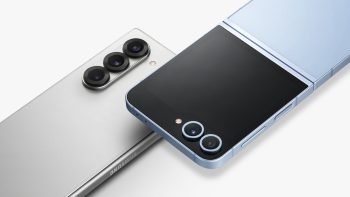
Samsung Galaxy Z Flip 6 versus Xiaomi Mix Flip
Just last week, Samsung announced their latest clamshell foldable, the Galaxy Z Flip 6. Not to be outdone, Xiaomi also announced a new foldable, the Mix Flip, which is also the company’s first clamshell foldable. If you’re trying to decide which phone to get, maybe seeing how the Galaxy Z Flip 6 is versus the Xiaomi Mix Flip will help you decide.
Design
Both handsets are designed to be clamshell foldables, so they are kind of similar in that regard. In terms of actual design, the design of the Flip 6 versus the Mix Flip aren’t that different. The more obvious difference would be in the external display, which we’ll cover in the next section. The camera placement is also slightly different, but admittedly overall the differences aren’t really night and day.
In terms of dimensions, the Flip 6 measures 165.1 x 71.9 x 6.9 mm when unfolded, and 85.1 x 71.9 x 14.9 mm when folded. The Mix Flip, on the other hand, measures 167.5 x 74 x 7.6 mm unfolded and 74 x 74 x 16 mm when folded. It also weighs around 190-192g versus the Flip 6 which weighs 187g.
So far, the Flip 6 looks like a smaller and lighter device compared to the Mix Flip. If size and weight are high on your list of priorities, the Flip 6 is the winner.
Display
As we previously mentioned, the displays are where the differences become a bit more obvious. The Flip 6 uses a 3.4-inch external display with a Super AMOLED panel that has a peak brightness of 1,700 nits. The Mix Flip has a larger 4-inch external display. It uses an AMOLED panel and has a higher peak brightness of 3,000 nits with a 120Hz refresh rate.
Unlike the Flip 6, the Mix Flip’s external display does not have a notch to keep the camera modules separate. Functionally it’s not too different, but the lack of a notch helps create a better illusion of a full screen design.
As for the internal foldable display, the Flip 6 has a 6.7-inch LTPO AMOLED display with a 120Hz refresh rate and a peak brightness of 2,600 nits. The Mix Flip has a slightly larger 6.86-inch LTPO AMOLED display with a 120Hz refresh rate and a higher peak brightness of 3,000 nits.
As you can see, the larger internal and external display of the Mix Flip accounts for the slightly larger dimensions and thickness of the phone versus the Flip 6.
Performance
Performance is where things start to become more similar again. Both handsets are powered by the Qualcomm Snapdragon 8 Gen 3 chipset. They also come with 12GB of RAM as its base, but the Mix Flip does have the option to go up to 16GB of RAM and 1TB of storage versus the Flip 6, which caps out at 12GB RAM and 512GB storage. Both phones use the same UFS 4.0 storage system which should offer similar read/write speeds.
Cameras
Both the Flip 6 and Mix Flip have a dual camera setup. Samsung did upgrade the main camera of the Flip 6 to a 50MP f/1.8 module over its predecessor. This is accompanied by a 12MP f/2.2 ultrawide.
The Mix Flip seems to fare better with a 50MP f/1.7 main which is accompanied by a 50MP f/2.0 telephoto. Megapixels don’t tell the whole story, but on paper the Mix Flip looks like it has the potential for better photos. Plus, the inclusion of the telephoto lens helps give users more options when it comes to taking photos and videos.
On the selfie cam front, the Flip 6 packs a 10MP f/2.2 camera while the Mix Flip has a 32MP f/2.0 camera.
Battery
Battery life is something we wished Samsung paid more attention to and unfortunately, the Flip 6 seems to have missed the mark. It features a 4,000mAh battery with 25W wired charging support and 15W wireless. It is more than usable and it is an upgrade over the Flip 5, but compared to the Mix Flip, it is disappointing.
Xiaomi’s Mix Flip packs a considerably larger 4,780mAh battery. It also supports 67W wired charging, allowing it to charge much faster compared to the Flip 6.
Pricing & availability
The Samsung Galaxy Z Flip 6 is priced starting at $1,099. It is currently available for purchase. Unfortunately, the Xiaomi Mix Flip is a bit more tricky. The handset is cheaper than the Flip 6 at around $824 (after conversion), but for now it looks like the Mix Flip is only available in China. Perhaps Xiaomi will have a global launch at a later date. But for now it might be difficult or near impossible to get your hands on it unless you live in China.
No products found.
Note: this article may contain affiliate links that help support our authors and keep the Phandroid servers running.